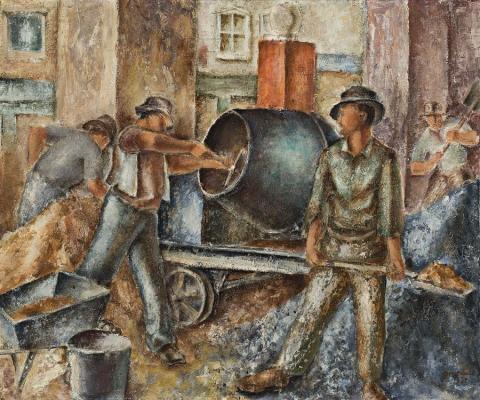MEN MIXING CONCRETE, 1937
RUSSELL DRYSDALE
oil on composition board
50.5 x 61.0 cm
signed and dated lower right: Drysdale / 1937
Joseph Brown Gallery, Melbourne
Private collection, Melbourne
Deutscher~Menzies, Melbourne, 3 September 2003, lot 45
The Hicks Family Collection, Melbourne
Russell Drysdale, Riddell's Galleries, Melbourne, 26 April – 7 May 1938, cat. 15
Russell Drysdale Retrospective Exhibition 1937 – 1960, Art Gallery of New South Wales, Sydney, 5 October – 6 November 1960, cat. 2, collection of the artist
Spring Exhibition 1976: Recent Acquisitions, Joseph Brown Gallery, Melbourne, 18 – 29 October 1976, cat. 68, (illus. in exhibition catalogue)
Burdett, B., 'Australian Art Today', The Studio, London, vol. CXV, no. 538, January 1938 (illus.)
Haefliger, P. (introduction), Russell Drysdale, a retrospective exhibition of paintings from 1937 to 1960, Ure Smith, for the Art Gallery of New South Wales, Sydney, 1960, cat. 2
Smith, B., Australian Painting 1788 – 1966, Oxford University Press, Melbourne, 1962, p. 243
Dutton, G., Russell Drysdale, Thames and Hudson, London, 1964, p. 106, pl. 2 (illus.)
Eagle, M. and Minchin, J., The George Bell School: Students, Friends, Influences, Deutscher Art Publications, Melbourne, 1981, pp. 76, 96 (illus.)
Klepac, L., The Life and Work of Russell Drysdale, Bay Books, Sydney, 1983, p. 33
The dignity of manual labour has long been part of our national iconography, exemplified by Tom Roberts' Shearing the Rams, ennobling the wool industry and those who worked in it. Russell Drysdale extended this to include sport, another form of physical prowess, in his The Cricketers 1948, elevating the informal cricket knock up against the wall of an outback pub to that of a national symbol. Men Mixing Concrete 1937 is another fine example in this same tradition, a brilliant, early product of its time showing Drysdale's youthful interest in figure subjects and physical labour. At George Bell's School, Melbourne, where Drysdale developed his rich talents during the years 1936 to 1938, the study of the human figure was of central importance. This is clearly apparent in Men Mixing Concrete, distinguished by its masterly drawing and giving his art its underlying strength. The same can be said of other early paintings from 1937 such as Study for a Mural and Sketch for 'Tempera Composition'. In addition, each shows an interest in mural painting and a striking classicism, with the emphasis on flat pictorial surfaces, bold simplification of forms, direct narrative, and a static composition through the ordered emphasis of verticals and horizontals. In Men Mixing Concrete the whole tone of the work is set by the nobly posed figure to the right, pictorially and thematically central to the artist's aims and ideas. While the dry texture of the paint is in keeping with its chalky colours, the limited palette is enlivened by the subtlety of the paint application. Moreover, Men Mixing Concrete and the similarly mural-inclined paintings show a particular appreciation of the great fresco painters of the Italian Quattrocento. It is by such means that Drysdale elevated the ordinary task of mixing concrete on a street corner into something touching on the heroic. These paintings of Drysdale's student years rightly show an interest in the work of artists as widely different as Picasso, Ingres, Tonks, Matisse, Rouault, Modigliani and Braque, Drysdale experimenting with eclectic ease in the forging of his own individual style. Chief influences at the Bell school were Cézanne, Fairweather and Bell himself.
When Men Mixing Concrete was shown in Drysdale's first solo exhibition the year after it was painted, he was enthusiastically hailed by the critics as an artist of much promise. The Melbourne Herald trumpeted 'Young Painter Shows Brilliant Promise' and its respected critic Basil Burdett summarised the show with'I have seldom seen a more promising exhibition by a young painter anywhere.1 'Works Indicate Brilliance' claimed The Sun News Pictorial, rightly predicting'a brilliant future'.2
1. Burdett, B., 'Young Painter Shows Brilliant Promise', Herald, Melbourne, 26 April 1938, p. 10
2. Sun News-Pictorial, Melbourne, 27 April 1938, quoted in Klepac, op. cit., p. 34
DAVID THOMAS
